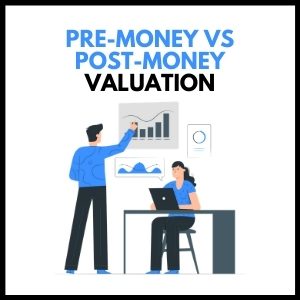Pre-money vs post-money valuation
As an Entrepreneur, you often have to negotiate on your company valuation
This is especially true when you are looking to raise new funding from investors and negotiating premoney vs postmoney valuation.
To get your funding, you need to mutually agree on the potential valuation of your company.
A very common yet confusing terminology in this context is the difference between pre-money and post-money valuation.
Let us explain this with a simplified numerical example.
Let us say there is a company ABC with two equal co-founders.
They start this company with $100,000 of total capital invested as equity in the company.
How did the co-founders estimate $100,000 capital requirement?
In all likelihood, the business plan of the company would have required this much initial investment.
It probably would cover the initial op-expenses + tech investment needed.
Each co-founder contributes $50,000 as equity capital.
At this stage, you may ask what is the valuation of this company?
Well, it is equal to the $100,000 invested by the two founders.
The reality is the business is currently on paper and hence the value of the business is at best the cash invested by the founders.
So, the valuation of the company is also $100,000.
In lieu of the equity contributed by the co-founders, company ABC issued them shares.
A share is a simple denomination of ownership in the company.
Each co-founder gets 5000 shares of this company ABC.
So what is the price per share then?
Simple maths, eh!
It is $10 per share (= $50,000 / 5000 shares)
The per share valuation of the company is $10 at the time of inception.
So, the business starts with this initial equity contributed by the founders.
A year passes by and the founders have been able to a create MVP of their product which actually sells in the market.
In other words, they have been able to establish initial traction with their customers who seem to like the product.
And they are making decent profit as well!
The founders decide to scale up the business from here on.
They would now want to expand further by hiring a team, investing to upgrade the initial technology and launch marketing campaigns to generate more business.
So now, they need more funding!
They approach some potential investors.
Investors ask the founders how much funding would they need? What is their growth plan? Can they show a financial model?
The founders huddle up and estimate that they would need $200,000 to meet the next year business plan.
After some discussion, investors agree!
Well, they had paying customers after all!
Hurray!
So there is this initial capital contributed by the founders at $100,000 and now investors would add another $200,000 in the company.
But wait?
What will be the ownership of investors in the company?
This is where we need to align on the valuation of the company.
The total equity capital post money invested by investors becomes $300,000.
Again, $100,000 of initial capital by founders and additional $200,000 by investors.
But now, this is no longer the valuation of the company.
This is the book value of equity of the company.
When we say valuation, we refer to the market value of equity of the company.
So we need to now estimate the market valuation of the company?
We can estimate the market value of the company at 2 points in time.
One before the money was invested in by the investors and second afterwards.
The value of the company before the founders reached out to investors is called pre-money valuation.
And the valuation of the company after the investors infuse equity in the company is post-money valuation.
Let us see how we arrive at the valuation estimates here then for this company.
Now, one approach to valuation is a negotiation-based approach.
This is not a scientific approach but really more a discussion-oriented approach between the founders and the investors.
The founders and investors agree on a 10% equity stake dilution in the company.
That is once the investors put $200,000 in the company, their ownership will be 10%.
So what will be the value of 100% of the company?
Again simple maths eh!
It is $200,000 divided by 10%.
This gives us $2,000,000 (U$ 2 mn).
The post money valuation of this company is $2mn.
Then what is the pre-money valuation of this company?
It is simply $2mn minus the $0.2 mn capital ($200,000) invested by the investors.
As such, it comes out to be $1.8 mn.
The pre-money valuation of this company is $1.8 mn.
What about the per-share value of the company?
Maths once again!
The two co-founders have 10,000 shares cumulative (remember this is what was issued to them at the beginning) .
The value of these shares is $1.8 mn (pre-money valuation).
So, the per share value will come out to be $180 per share which is
= $1.8 mn / 10,000 shares
= $180 per share
How does the company ownership (cap chart) look like now?
Something like this:
|
|
Capital invested |
# of equity shares |
Price per share |
Valuation (U$ ) |
Ownership (%) |
|
Founder 1 |
$50,000 |
5000 |
$180 |
$0.9mn |
45% |
|
Founder 2 |
$50,000 |
5000 |
$180 |
$0.9mn |
45% |
|
Investors |
$200,000 |
1111 |
$180 |
$0.2mn |
10% |
|
Total |
$300,000 |
11,111 |
$180 |
$2mn |
100% |
For more detailed understanding of how to



One thought on “Premoney vs Postmoney Valuation: Understanding the Differences”
📊 Chart Whisperer | Reading Market Secrets 🔍
💡 Illuminating Trades | Strategy Magician ✨… more